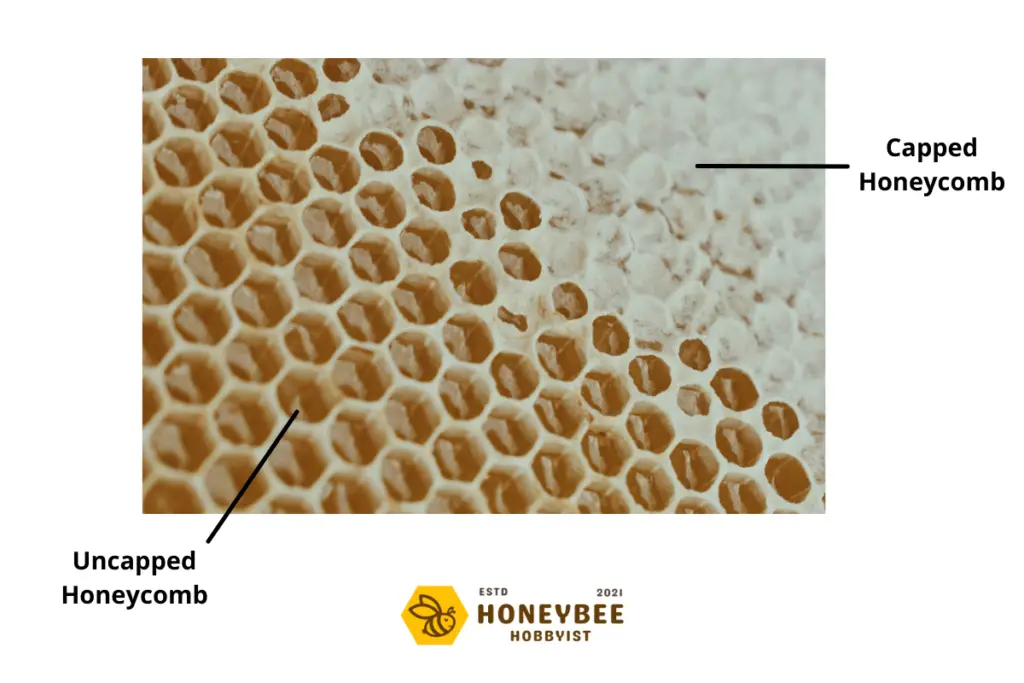Bees are amazing creatures that do so much for us. One of their most significant achievements is the production of honey. It really is amazing how bees make honey, so let’s dive into the process.
How do bees make honey?
Worker bees collect pollen and nectar from flowering plants. While delivering the nectar in their honey stomachs, two enzymes from their saliva are mixed in. Once at the hive, the nectar is placed inside individual honeycomb cells. The bees then flap their wings, fanning the nectar, which reduces the moisture content, turning it into honey. The honeycomb cells are then capped with wax and preserved.
To learn more about honey production, continue reading below;
Step #1 – Worker Bees Forage For Nectar
Worker bees fly upwards of six miles per day at an average speed of 12 miles per hour. They may visit as many as 50,000 flowers per day to act as pollinators and gather the scant amount of pollen & nectar they need to make honey.
Nectar is made of three sugars: sucrose, glucose, and fructose, plus some scent chemicals to help draw bees to the flowers.
Plus, the nectar and pollen from varying plant life contribute to the different types of honey we love to consume.
The nectar is sucked up using its long tongue called the proboscis. It is then swallowed into the bee’s honey stomach, capturing two enzymes from the bee’s saliva while the nectar enters its mouth.
One of these enzymes is called invertase, which breaks the sucrose down into simple sugars.
When the nectar is combined with these two enzymes, the honey-making process begins.

For additional insight into honey bee anatomy, click here.
Step #2 – Nectar Is Delivered To Other Bees In The Hive
Once their honey stomach is full, they fly back to the hive and transfer the nectar to other worker bees.
The worker bees regurgitate the nectar, passing it mouth-to-mouth to the house bees. As the nectar is passed along, it is also chewed, which continues the enzyme mixing process. This changes the pH of the mixture, which means it contains too much moisture for it to be stored.
After finding a good source of food, honey bees will often perform the waggle dance to tell the other bees how far and in what direction that source of pollen or nectar is.
Step #3 – Honeybees Fan The Syrup With Their Wings
The hive’s internal temperature is around 90.5°F, which is warm enough that water in nectar begins to evaporate.
The house bees begin to spread the mixture across the honeycomb. By increasing the surface area, moisture naturally evaporates, which reduces the moisture content.
As that process continues, bees fan their wings over the opening of the honeycomb cells. This helps increase airflow and speeds up the evaporation process.
Once the water content is between 13 and 18 percent, down from 70 percent when it first arrived at the hive, the bees begin to cap the honeycomb.
Fun Fact: Honey can vary in weight based on multiple factors, including moisture content. Click here to learn more.
Step #4 – Honeycomb Is Capped With Bees Wax
As each batch of nectar stored in the open honeycomb reaches the right consistency, the worker bees cap it with more beeswax.
Once capped, it is preserved in the cells.

Why Do Bees Make Honey?
Humans have been consuming honey for thousands of years, and it has been our primary source of sugar/sweetener since the 16th century.
But bees don’t produce it for our sake!
The primary reason why bees make honey is to store food for the cold winter months. During these winter months, floral sources aren’t available to collect nectar, so it’s important that the colony of bees sustain itself with capped honeycomb resources.
And they need quite a bit to get them through those lean months too.
Some estimates show that a single colony of bees needs at least 40 pounds of honey to survive the winter season. And in colder regions, they may need as much as 80 to 90 pounds of honey stored.
When we consider how much honey a single bee produces in its short lifetime (1/12 of a teaspoon), it’s easy to see how important things like the health of the colony and responsible beekeeping are for the survival of the bees.
Okay…let’s move on to your real question….How Is Honey Made Exactly?
How much honey does a bee colony produce?
An entire colony of bees can make around 5.4 gallons of honey per year. That’s roughly 45 pounds of honey.
Each bee will produce approximately 1/12 of a teaspoon within its lifespan which is up to six weeks.
For more information on how much honey bees make, click here.
Are There Different Types Of Honey
Yes, there are different types of honey.
This is dependent upon the plants they visit to collect nectar. For example, honey may have a unique scent or flavor profile of blueberry if the bees visit blueberry bushes.
Darker colored honey will often have a sweeter flavor profile than the lighter colored variations.
Plus, honeybees are often eager to collect a substance called honeydew. A sweet sticky substance from insect poop is produced after the insects consume the sap stored inside plant leaves.
Unfortunately, this is why there is some confusion about whether honey is bee poop.
Honeydew Honey is highly-sought after. Enough so that beekeepers perform electrical conductivity tests to ensure it has a minimum of 0.8 milliSiemens/cm. If it has less than 0.8 milliSiemens/cm, it cannot be labeled as honeydew honey.
How do beekeepers process the honey they collect?
First off, don’t neglect raw honeycomb. It’s one of our favorite ways to eat honey! Here are a few ways you can eat honeycomb straight from the hive.
In commercial beehives, the beekeeper removes the honeycombs, which are set in frames.
Next, they carefully remove the beeswax caps that the worker bees place on the cells.
From there, the honey is extracted from the honeycomb through a centrifugal process which spins the honeycomb. Gravity forces the honey out of the sells and into the centrifugal vat.
Once the honeycombs are depleted of honey, the honey is strained. This process removes any small pieces of wax or other material that might be in the honey.
From there, the honey goes into a bottle, and the label is applied. Finally, it is sealed, packaged, and shipped out to stores where consumers buy it.
One additional honey processing step is to whip up the raw honey into creamed honey. Click here to learn more.
Fun Fact: It takes about 680 bees to make one 9.5-ounce jar of honey.

